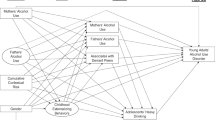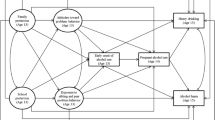Abstract
We examined drinking behavior of parents, siblings, and friends of twins as predictors of adolescent and young adult problem drinking over a period of 2 and a period of 7 years. Data of 12 to 30-year-old twins and their family members from the Netherlands Twin Register were analyzed. Problem drinking in twins was assessed in 1995 and 2000 and was defined based on the CAGE and amount of drinking. Data on alcohol use of parents, siblings and friends were collected in 1993. Multinomial logistic regression analyses were used to examine the short-term (1993–1995; n = 2,994) and the long-term longitudinal predictors (1993–2000; n = 1,796) of problem drinking. Age, sex and own alcohol use in 1993 explained 25% of the variance in adolescent and young adult problem drinking. Moreover, adolescents and young adults with fathers who drank frequently and with a large numbers of drinking friends, were at the highest risk for problem drinking 2 years later. Over a period of 7 years the number of drinking friends was no longer a risk factor, but few times a week or daily alcohol use of fathers remained a risk factor for later problem drinking. Drinking behavior of mother and siblings did not substantially predict problem drinking. Sex and age did not moderate these effects.
Similar content being viewed by others
References
Andrews JA, Tildesley E, Hops H, Li F (2002) The influence of peers on young adult substance use. Health Psychol 21:349–357
Ary DV, Tildesley E, Hops H, Andrews J (1993) The influence of parent, sibling, and peer modeling and attitudes on adolescent use of alcohol. Int J Addictions 28:853–880
Bauman KE, Ennett ST (1996) On the importance of peer influence for adolescent drug use: commonly neglected considerations. Addiction 91:185–198
Bisson J, Nadeau L, Demers A (1999) The validity of the CAGE scale to screen for heavy drinking and drinking problems in a general population survey. Addiction 94:715–722
Boomsma DI, Vink JM, Van Beijsterveldt TCEM, De Geus EJC, Beem AL, Mulder EJCM, Derks EM, Riese H, Willemsen G, Bartels M, Van den Berg M, Kupper NHM, Polderman TJC, Posthuma D, Rietveld MJH, Stubbe JH, Knol LI, Stroet T, Van Baal GCM (2002) Netherlands Twin Register: a focus on longitudinal research. Twin Res 5:401–406
Boomsma DI, De Geus EJC, Vink JM, Stubbe JH, Distel MA, Hottenga JJ, Posthuma D, Van Beijsterveldt TCEM, Hudziak JJ, Bartels M, Willemsen G (2006) Netherlands Twin Register: from twins to twin families. Twin Res Hum Genet 9:849–857
Bot SM, Engels RCME, Knibbe RA, Meeus WHJ (2005) Friend’s drinking behaviour and adolescent alcohol consumption: the moderating role of friendship characteristics. Addict Behav 30:929–947
Chung T, Colby SM, Barnett NP, Rohsenow DJ, Spirito A, Monti PM (2000) Screening adolescents for problem drinking: performance of brief screens against DSM-IV alcohol diagnoses. J Stud Alcohol 61:579–587
Duncan SC, Alpert A, Duncan TE, Hops H (1997) Adolescent alcohol use development and young adult outcomes. Drug Alcohol Depend 49:39–48
Ellickson PL, Tucker JS, Klein DJ, McGuigan KA (2001) Prospective risk factors for alcohol misuse in late adolescence. J Stud Alcohol 62:773–782
Ewing JA (1984) Detecting alcoholism. The CAGE questionnaire. J Am Med Assoc 252:1905–1907
Graham JW, Marks G, Hansen WB (1991) Social influence processes affecting adolescent substance use. J Appl Psychol 76:291–298
Griffin KW, Botvin GJ, Epstein JA, Doyle MM, Diaz T (2000) Psychosocial and behavioral factors in early adolescence as predictors of heavy drinking among high school seniors. J Stud Alcohol 61:603–606
Gruber E, DiClemente RJ, Anderson MM, Lodico M (1996) Early drinking onset and its association with alcohol use and problem behavior in late adolescence. Prev Med 25:293–300
Guilamo-Ramos V, Turrisi R, Jaccard J, Wood E, Gonzalez B (2004) Progressing from light experimentation to heavy episodic drinking in early and middle adolescence. J Stud Alcohol 65:494–500
Hajema KJ, Knibbe RA (1998) Changes in social roles as predictors of changes in drinking behaviour. Addiction 93:1717–1727
Hingson R, Heeren T, Zakocs R, Winter M, Wechsler H (2003) Age of first intoxication, heavy drinking, driving after drinking and risk of unintentional injury among U.S. college students. J Stud Alcohol 64:23–31
Loxley W, Toumbourou JW, Stockwell T, Haines B, Scott K, Godfrey C, Waters E, Patton G, Fordham R, Gray D, Marshall J, Ryder D, Saggers S, Sanci L, Williams J (2004) The prevention of substance use, risk and harm in Australia: a review of the evidence. The National Drug Research Centre and the Centre for Adolescent Health, Canberra
McCarty CA, Ebel BE, Garrison MM, DiGiuseppe DL, Christakis DA, Rivara FP (2004) Continuity of binge and harmful drinking from late adolescence to early adulthood. Pediatrics 114:714–719
McGue M, Sharma A, Benson P (1996) Parent and sibling influences on adolescent alcohol use and misuse: Evidence from a U.S. adoption cohort. J Stud Alcohol 57:8–18
Statistics Netherlands (2004) http://www.cbs.nl/nl/cijfers/statline
O’Neill SE, Parra GR, Sher KJ (2001) Clinical relevance of heavy drinking during the college years: cross-sectional and prospective perspectives. Psychol Addict Behav 15:350–359
Ouellette JA, Gerrard M, Gibbons FX, Reis-Bergan M (1999) Parents, peers, and prototypes: antecedents of adolescent alcohol expectancies, alcohol consumption, and alcohol-related life problems in rural youth. Psychol Addict Behav 13:183–197
Petraitis J, Flay BR, Miller TQ (1995) Reviewing theories of adolescent substance use: organizing pieces in the puzzle. Psychol Bull 117:67–86
Poelen EAP, Scholte RHJ, Engels RCME, Boomsma DI, Willemsen G (2005) Prevalence and trends of alcohol use and misuse among adolescents and young adults in the Netherlands from 1993 to 2000. Drug Alcohol Depend 79:413–421
Poelen EAP, Scholte RHJ, Willemsen G, Boomsma DI, Engels RCME (2007) Drinking of parents, siblings, and friends as predictors of regular alcohol use in adolescents and young adults: a longitudinal twin-family study. Alcohol Alcohol 42:362–369
Reifman A, Barnes GM, Dintcheff BA, Farrell MP, Uhteg L (1998) Parental and peer influences on the onset of heavier drinking among adolescents. J Stud Alcohol 59:311–317
Schulenberg JE, Maggs JL (2002) A developmental perspective on alcohol use and heavy drinking during adolescence and the transition to young adulthood. J Stud Alcohol Suppl 14:54–70
Silberg J, Rutter M, D’Onofrio B, Eaces L (2003) Genetic and environmental risk factors in adolescent substance use. J Child Psychol Psychiatry 44:664–676
Smart RG, Adlaf EM, Knoke D (1991) Use of the CAGE scale in a population survey of drinking. J Stud Alcohol 52:593–596
Tucker JS, Orlando M, Ellickson PL (2003) Patterns and correlates of binge drinking trajectories from early adolescence to young adulthood. Health Psychol 22:79–87
Urberg KA, Değirmencioğlu SM, Pilgrim C (1997) Close friend and group influence on adolescent cigarette smoking and alcohol use. Dev Psychol 33:834–844
Van Dijck D, Knibbe RA (2005) De prevalentie van probleemdrinken in Nederland: Een algemeen bevolkingsonderzoek [The prevalence of problem drinking in the Netherlands: a general population study]. Universiteit Maastricht, Maastricht
Vink JM, Willemsen G, Stubbe JH, Middeldorp CM, Ligthart RSL, Baas K, Dirkzwager H, De Geus E, Boomsma DI (2004) Estimating non-response bias in family studies: application to mental health and lifestyle. J Epidemiol 19:623–630
Walden B, Iacono WG, McGue M (2007) Trajectories of change in adolescent substance use and symptomatology: Impact of paternal and maternal substance use disorders. Psychol Addict Behav 21:35–43
Wechsler H, Davenport A, Dowdall G, Moeykens B, Castillo S (1994) Health and behavioral consequences of binge drinking in college: a national survey of students at 140 campuses. J Am Med Assoc 272:1672–1677
Windle M (2000) Parental, sibling, and peer influences on adolescent substance use and alcohol problems. Appl Dev Sci 4:98–110
Wood MD, Read JP, Palfai TP, Stevenson JF (2001) Social influence processes and college student drinking: the mediational role of alcohol outcome expectancies. J Stud Alcohol 62:32–43
Wood MD, Read JP, Mitchell RE, Brand NH (2004) Do parents still matter? Parent and peer influences on alcohol involvement among recent high school graduates. Psychol Addict Behav 18:19–30
Young SE, Rhee SH, Stallings MC, Corley RP, Hewitt JK (2006) Genetic and environmental vulnerabilities underlying adolescent substance use and problem use: general or specific? Behav Genet 36:603–615
Author information
Authors and Affiliations
Corresponding author
Rights and permissions
About this article
Cite this article
Poelen, E.A.P., Engels, R.C.M.E., Scholte, R.H.J. et al. Predictors of problem drinking in adolescence and young adulthood. Eur Child Adolesc Psychiatry 18, 345–352 (2009). https://doi.org/10.1007/s00787-009-0736-x
Received:
Accepted:
Published:
Issue Date:
DOI: https://doi.org/10.1007/s00787-009-0736-x




